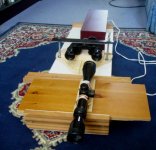Thanks for all of that O.N and bencw and sorry for delay in acknowledgement. Familiy wedding over the week end which took over events though I did manage to scrounge a 4x28 scope for the collimator ( 8" long so will that be OK or too short?) and then the promise of a 2nd edition Hans Seeger book and, things happen in 3's, an arranged viewing/purchase of a Barr and Stroud Admiraly set of CF25, so a productive couple of days. Thanks Bencw for the picture, certainly would have escaped me to position the bins that way around ( a picture paints a 1000 words!) One thing also alludes me - is there a technique to retaining the white inscriptions when/if doing a total respray job of the binocular ( again, sorry to the discerning collector) On the case with the spanner wrench and then - here's hoping, away I go! A lot of P.C required, patience and confidence.:t:
Hi Koyote,
8" is fine for the scope, the Hans Seeger book sounds a good find. In respect of the white inscriptions, this can be tricky. If they are still good and it is just the edges of plates that need paint, I mask off the white inscriptions and carefully spray, then take the masking off and give it all a clear lacquer.
If that is not possible, it's more difficult, as long as the inscription is engraved, in indentations, I spray the whole part black, let dry, use a sharp pin to scratch out the engravings and let the black coating dry hard, a few days. Then using white emulsion and a small brush, paint in the lettering, scrape off excess with card, it will leave some white smears, leave it just long enough to dry, and then you should be able to wipe of the emulsion smears with a damp cloth or a little cleaning alcohol, leaving the inscription white. Then spray all over with clear lacquer. One thing to keep in mind, most collectors like Military binoculars, untouched, with all their battle scars as it were, I prefer to get mine back to looking as good as I can, but if it was a rare and valuable binocular, like for example a BIC U Boat 8x60, or kriegsmarine 7x50 servicing may be fine but I think best leave the cosmetics alone.
Also, probably obvious, but work over a table when dismantling or assembling, and cover the table with one of those soft fleecy type car blankets, then if you drop a small screw, it won't bounce onto the floor, and if you drop a prism it probably wont damage it.




